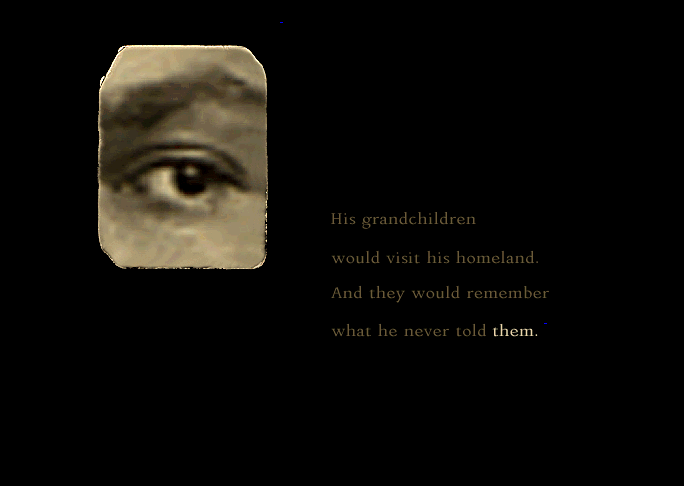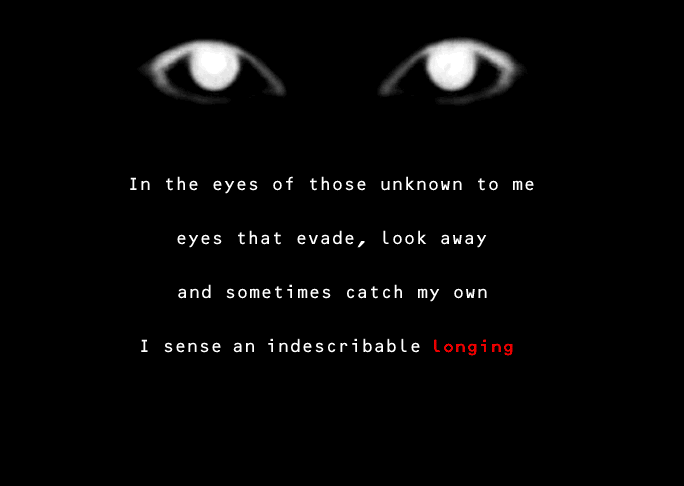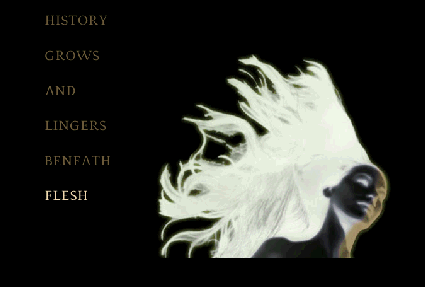Projects reviewed in this article:
Ideally suited for collaborative artistic efforts, the Web allows for experiments with innumerable combinations of creative endeavor. 6168, an art space exhibiting Web-specific projects by new media artists Peter Horvath and Sharon Matarazzo, is a collaborative project that succeeds in combining two distinct voices into creative unity. "6168" doesn't try to explore or push the limits of technology, and the artists' decidedly minimalistic approach contributes to the site's elegance. The six projects presented here each have a distinct voice and vision, yet there are underlying narratives holding them together. Both Horvath's Three Times Removed and Matarazzo's Elsewhere are projects concerned with memory, notions of history, place and self.
Combining text, photos and animations, "Three Times Removed" uses the digital medium to reconstruct a family history through generational memories. The narrative consists of lyrical fragments, such as glimpses of a childhood in wartime Budapest, and images that become tokens of memory. The yellowish tint of the digitized photos imitates the sepia tones of old photographs, mementos resurfacing from the past. Watching these photographs download turns remembrance into a process where memories slowly materialize. "Three Times Removed" doesn't offer many options for navigation, but what might be dismissed as a lack of interactivity actually works in favor of the project: the interface moves you along as memories do.
"Three Times Removed" allows visitors to contribute thoughts on memory, family, and self, which are posted at the site, and one contributor's comments manage to capture what it is that makes this project alluring: "the echoing sssounds of the ss S ss oul, fragmented moments reflecting the presence of being here and now, history, the stories we tell ourselves to understand where we are and how we arrived." Memory, after all, seems to be an ideal subject for this medium that genuinely lends itself to conveying fragments, interwoven stories, and a continuous process of arrival and departure.
 A different take on the subject of place and self is offered by Sharon Matarazzo's Elsewhere, "A pilgrimage to the intangible." In three sections--Somewhere, Nowhere, Elsewhere--reflections on personal history and the (navigational) choices we make are combined with a montage composed of images submitted via e-mail.
A different take on the subject of place and self is offered by Sharon Matarazzo's Elsewhere, "A pilgrimage to the intangible." In three sections--Somewhere, Nowhere, Elsewhere--reflections on personal history and the (navigational) choices we make are combined with a montage composed of images submitted via e-mail.
Horvath's Jamaica Journal, which was the first project exhibited at the site, also revolves around the topic of place and identity, documenting an encounter of North American and Jamaican culture within a personal frame of experience.
Three of the projects presented here--Horvath's The Guide and Matarazzo's Longings and Mona Says--invite visitors to respond with their impressions, experiences and opinions. "The Guide" can be accessed by clicking on the image of an old TV set; choosing a channel (by clicking on numbers) leads visitors to clippings from a TV guide; the attempt to provide two-sentence summaries of a movie is in itself humorous, and the fact that these decontextualized excerpts have no functionality for the medium they are presented in makes them even funnier.
Contributions by previous visitors provide the characteristic mix of anonymous Web postings--"a disease"... "babysitter"... "The Symbol of My Generation."... "an emptiness filled with emptiness"... "the hardware of our macroconsciousness"... "A place on which to set my stereo."--but, at best, stimulate reflection on the characteristics of the two media, Web and TV. One comment dismisses the TV as a played-out medium, a waste of mindspace and replacement for community, another one longs for the combination of TV and computer, so that "we can choose what we watch." (WebTV has arrived on the market--but we still aren't there yet.)
 The "Longings" submitted by visitors to the site include everything from chocolate and a new computer to a specific person or an ideal of love, and "Mona Says"--built around the question whether Mona Lisa needs a man--lists more nonsensical than thought-provoking replies ("Stupid question. I'm not alive, I'm a painting."). The postings to all three projects range from the ridiculous to the sublime and reflect the best and worst qualities of the Web. Yet, those unfiltered and random responses have an attraction of their own.
The "Longings" submitted by visitors to the site include everything from chocolate and a new computer to a specific person or an ideal of love, and "Mona Says"--built around the question whether Mona Lisa needs a man--lists more nonsensical than thought-provoking replies ("Stupid question. I'm not alive, I'm a painting."). The postings to all three projects range from the ridiculous to the sublime and reflect the best and worst qualities of the Web. Yet, those unfiltered and random responses have an attraction of their own.
As the introduction to "Longings" tells us, "In the eyes of those unknown to me, eyes that evade, look away, and sometimes catch my own, I sense an indescribable longing"; the thoughts collected at this site may have a similar effect on the visitor, that of a casual look, an evasion or perhaps connection--a glimpse of identity and personal history.
|
 REMEMBRANCES OF THINGS PAST
REMEMBRANCES OF THINGS PAST REMEMBRANCES OF THINGS PAST
REMEMBRANCES OF THINGS PAST